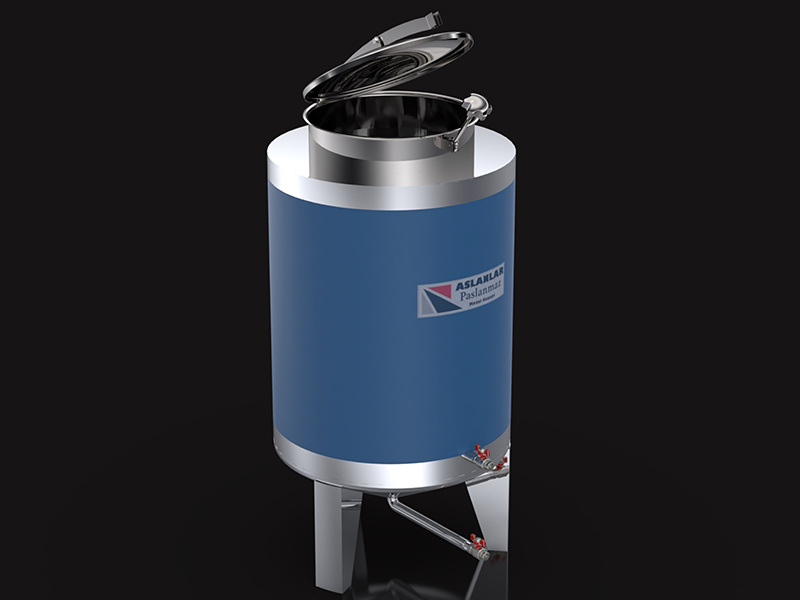Paslanmaz yağ tankları, endüstriyel süreçlerde vazgeçilmez bir rol oynayan ve genellikle çeşitli sektörlerde kullanılan özel depolama kaplarıdır. Bu tanklar, özellikle korozyona karşı dayanıklı olmaları, hijyenik özellikleri ve uzun ömürlü yapılarıyla öne çıkar. Bu yazıda, paslanmaz yağ tanklarının endüstrideki önemini, avantajlarını ve kullanım alanlarını detaylı bir şekilde inceleyeceğiz.
Paslanmaz Çelik Nedir?
Paslanmaz Çeliğin Özellikleri
Paslanmaz çelik, demir, karbon ve krom elementlerinden oluşan bir alaşımdır. Paslanmaz çeliğin en belirgin özelliği, krom içeriği sayesinde korozyona karşı yüksek direnç göstermesidir. Bu malzeme aynı zamanda dayanıklı, uzun ömürlü ve bakım gerektirmeyen yapısıyla bilinir.
Farklı Paslanmaz Çelik Türleri
Paslanmaz çelik, bileşenlerinin oranlarına ve üretim süreçlerine göre farklı türlere ayrılır. 304 ve 316 tipi paslanmaz çelik, yağ tanklarında en yaygın kullanılan türlerdir. 316 tipi, daha fazla molibden içermesi nedeniyle deniz suyu ve asidik ortamlar gibi zorlu koşullarda tercih edilir.
Paslanmaz Yağ Tanklarının Yapısı
Tankların Genel Yapısı
Paslanmaz yağ tankları, genellikle silindirik veya dikdörtgen şekillerde tasarlanır. İç yüzeyleri, yağın kalitesini korumak için pürüzsüz ve hijyenik olmalıdır. Dış yüzeyleri ise dayanıklılığı artırmak amacıyla ek koruyucu kaplamalarla güçlendirilir.
Kullanılan Malzemeler
Bu tanklarda kullanılan paslanmaz çelik, yüksek dayanıklılık ve korozyon direnci sunar. Aynı zamanda, tankların iç yüzeylerinde yağın kalitesini korumak için gıda sınıfı malzemeler kullanılır.
Üretim Süreci
Paslanmaz yağ tankları, hassas üretim süreçleri gerektirir. Malzemeler özenle seçilir, tankın şekli ve boyutu belirlenir ve kaynak işlemleri dikkatle yapılır. Üretim sürecinin sonunda tanklar kalite kontrol testlerinden geçirilir.
Paslanmaz Yağ Tanklarının Avantajları
Dayanıklılık ve Uzun Ömür
Paslanmaz çelik, aşırı sıcaklık, basınç ve kimyasal maddelere karşı son derece dayanıklıdır. Bu özellikler, paslanmaz yağ tanklarının uzun ömürlü olmasını sağlar.
Korozyona Karşı Direnç
Paslanmaz çelik tanklar, korozyona karşı yüksek direnç gösterir. Bu sayede tankların içindeki yağın kalitesi korunur ve tankların ömrü uzar.
Hijyenik Özellikler
Paslanmaz çelik, bakteri ve mikrop barındırmayan pürüzsüz bir yüzeye sahiptir. Bu nedenle, özellikle gıda ve ilaç endüstrisinde tercih edilir.
Endüstriyel Uygulamalar
Gıda Sektöründe Kullanım
Paslanmaz yağ tankları, gıda sektöründe bitkisel yağlar, tereyağı ve margarin gibi ürünlerin depolanmasında kullanılır. Hijyenik yapısı, gıda güvenliği açısından büyük önem taşır.
Kimya ve İlaç Sektöründe Kullanım
Kimya ve ilaç sektöründe, paslanmaz çelik tanklar, kimyasal maddelerin ve ilaçların güvenli bir şekilde depolanması için idealdir. Bu tanklar, kimyasalların saflığını korur ve dış etkenlere karşı dayanıklıdır.
Petrol ve Gaz Endüstrisinde Kullanım
Petrol ve gaz endüstrisinde de paslanmaz yağ tankları yaygın olarak kullanılır. Bu tanklar, petrol ürünlerinin güvenli bir şekilde depolanmasını sağlar ve çevresel riskleri minimize eder.
Paslanmaz Yağ Tanklarının Boyutları ve Kapasitesi
Farklı Boyut Seçenekleri
Paslanmaz yağ tankları, farklı boyutlarda üretilir. İhtiyaca göre küçük depolama kapasitelerine sahip tanklar veya büyük endüstriyel tanklar tercih edilebilir.
Kapasite Hesaplama
Tank kapasitesi, depolanacak yağın miktarına göre belirlenir. Kapasite hesaplaması yapılırken, tankın kullanılacağı yer ve depolama koşulları da göz önünde bulundurulmalıdır.
Bakım ve Temizlik
Paslanmaz Yağ Tanklarının Bakımı
Paslanmaz yağ tanklarının düzenli bakımı, tankların ömrünü uzatır ve işlevselliğini korur. Bakım sırasında tankın dış yüzeyi ve iç yüzeyi kontrol edilir, gerekli durumlarda temizlenir ve onarılır.
Temizlik Yöntemleri
Paslanmaz çelik tankların temizliği, tankın iç yüzeyine zarar vermeyen özel temizleyiciler kullanılarak yapılır. Ayrıca, sterilizasyon işlemleri de tankların hijyenik kalmasını sağlar.
Güvenlik Önlemleri
Güvenli Kullanım İçin Alınması Gereken Tedbirler
Paslanmaz yağ tanklarının güvenli kullanımı için belirli önlemler alınmalıdır. Tankların kurulumu sırasında doğru yerleşim ve bağlantılar yapılmalı, kullanım sırasında ise tankın basıncı ve sıcaklığı düzenli olarak kontrol edilmelidir.
Yangın ve Patlama Riskleri
Paslanmaz yağ tanklarının kullanımı sırasında yangın ve patlama risklerine karşı dikkatli olunmalıdır. Bu nedenle, tankların yakınında ateş veya kıvılcım oluşturabilecek işlemlerden kaçınılmalıdır.
Maliyet ve Ekonomik Faydalar
Uzun Vadede Maliyet Analizi
Paslanmaz çelik tanklar, başlangıçta yüksek maliyetli olabilir. Ancak, uzun vadede dayanıklılığı ve düşük bakım gereksinimi sayesinde maliyet avantajı sağlar.
Enerji Verimliliği ve Tasarruf
Paslanmaz yağ tankları, enerji verimliliği sunar. Isı yalıtımı ve yüksek dayanıklılık, enerji tasarrufu sağlar ve işletme maliyetlerini düşürür.
Paslanmaz Yağ Tanklarının Satın Alınması
Doğru Tankı Seçmek
Paslanmaz yağ tankı satın alırken, tankın kullanılacağı alan, depolanacak yağın türü ve miktarı gibi faktörler göz önünde bulundurulmalıdır. Ayrıca, tankın üreticisinin güvenilirliği ve ürün garantisi de önemlidir.
Dikkat Edilmesi Gereken Hususlar
Satın alma sürecinde, tankın üretim kalitesi, kullanılan malzemelerin dayanıklılığı ve üretici firmanın sunduğu teknik destek hizmetleri gibi unsurlar dikkatlice değerlendirilmelidir.
Çevresel Etkiler
Geri Dönüşüm ve Çevre Dostu Özellikler
Paslanmaz çelik, geri dönüştürülebilir bir malzemedir. Bu nedenle, paslanmaz yağ tankları çevre dostu bir seçenektir ve sürdürülebilirlik açısından avantaj sağlar.
Karbon Ayak İzinin Azaltılması
Paslanmaz yağ tankları, uzun ömürlü yapıları sayesinde daha az atık üretir ve çevresel etkileri minimize eder. Bu da işletmelerin karbon ayak izini azaltmalarına yardımcı olur.
Paslanmaz Yağ Tanklarının Geleceği
Teknolojik Gelişmeler
Paslanmaz yağ tankları, teknolojik gelişmelerle birlikte daha da gelişmektedir. Özellikle akıllı sensörler ve otomatik kontrol sistemleri, tankların verimliliğini artırmaktadır.
Gelecekteki Trendler
Gelecekte, paslanmaz yağ tanklarının daha çevre dostu ve enerji verimli modelleri geliştirilecektir. Ayrıca, sürdürülebilir üretim süreçleri ve geri dönüştürülebilir malzemeler kullanımının artması beklenmektedir.
Paslanmaz yağ tankları, endüstriyel süreçlerde vazgeçilmez bir öneme sahiptir. Dayanıklılık, hijyen, korozyon direnci gibi avantajları sayesinde, farklı sektörlerde geniş bir kullanım alanı bulur. Uzun vadede sağladığı maliyet avantajı ve çevre dostu özellikleri ile paslanmaz yağ tankları, işletmeler için ideal bir depolama çözümüdür.
Paslanmaz yağ tankları, doğru bakım yapıldığında 20-30 yıl gibi uzun bir süre dayanabilir.
Evet, paslanmaz çelik tanklar geri dönüştürülebilir oldukları için çevre dostudur.
Evet, farklı yağ türleri için ayrı tanklar kullanmak, yağların kalitesini korumak açısından önemlidir.
Hayır, paslanmaz yağ tanklarının bakımı düzenli yapıldığı sürece zor değildir.
Gıda, kimya, ilaç, petrol ve gaz gibi birçok endüstri paslanmaz yağ tanklarını kullanmaktadır.


